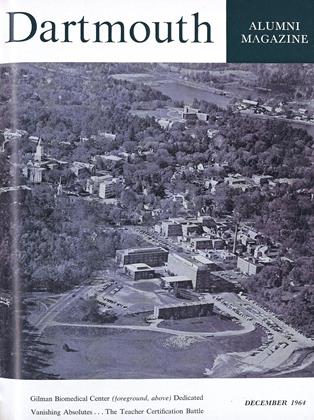FRANCIS LANE CHILDS '06, Professor of English Emeritus and more familiarly known to today's undergraduates for his wonderful Freshman Week lecture on Dartmouth history, wrote in The Hanover Bicentennial Book,1761-1961 about a Hanover farm mother, Mrs. Irene Foster, who during the 14 years that her seven sons attended Dartmouth, 1837 to 1851, had read every book in the Dartmouth College library.
Mrs. Foster undoubtedly would have a field day picking and choosing from the 850,000 volumes in today's Dartmouth College Libraries, but even with all the labor-saving devices now available to farm mothers she would have to spend most of her hours book in hand to make even a small dent in the Library's monthly listing of "Recent Acquisitions." And not only that, she would have to be able to read German, French, Italian, Portuguese," Russian, Norwegian, Latin, Greek, Spanish, Japanese, and the "language" of science and technology. Mrs. Foster probably wouldn't use the term "explosion in knowledge," but her awe and frustration at not being able to achieve any great or broad inroads would not be too far removed from that experienced by many in this community of scholars.
The "Recent Acquisitions" list for the month of November 1964, for instance, lists a total of 858 new entries ranging from The Soybean: Genetics, Breeding,Physiology and A Reconnaissance SoilSurvey of the Semporna Peninsula NorthBorneo under the opening heading of "Agriculture" to Sumner Zacks' TheMotor Endplate and Hans Zinsser's Microbiology under the special listing for the Dana Biomedical Library.
Historians made the great leap forward the November listing with 158 new entries to the collection from Agerpres - A Short Document on Rumania to Solomon Zeitlin's The Rise and Fall of theJudaean State. Among the 85 listed for "Art" were many from abroad or about creativity in other lands. Dana Biomedical gained 71 new publications and there were 53 in Economics. Fontes ad topographiam veteris Urbis Romae was the lone listing for Archaeology, one less than reported for Biography, Astronomy, and Psychology. The number of entries in each category varies from month to month depending upon the needs of faculty and student body, the insight and energy of authors, and the whims of the publishing world. This time, apparently, the greatest need or activity was booked by History, Art, Economics, Music, Mathematics, and Religion.
All entries in "Recent Acquisitions" do not represent the "new" although the great majority, of course, are newly published. Several on the November "new books" pages were published in the 19th Century and one in the 18th. The lastnamed might well have been read by the worthy Mrs. Roberts.
 View Full Issue
View Full Issue
More From This Issue
-
 Feature
FeatureVANISHING ABSOLUTES
December 1964 -
 Feature
FeatureOur Battle To Reform The Education of Teachers
December 1964 By THOMAS W. BRADEN '40 -
 Feature
FeaturePRESIDENT'S POLLSTER
December 1964 By CLIFFORD L. JORDAN '45 -
 Feature
FeatureTwin Pillar of Alumni Support
December 1964 By FORD H. WHELDEN '25 -
 Feature
FeatureGilman Biomedical Centedicated
December 1964 -
 Article
ArticleNine John Ledyards, Modern Style
December 1964 By BOB WILDAU '65







